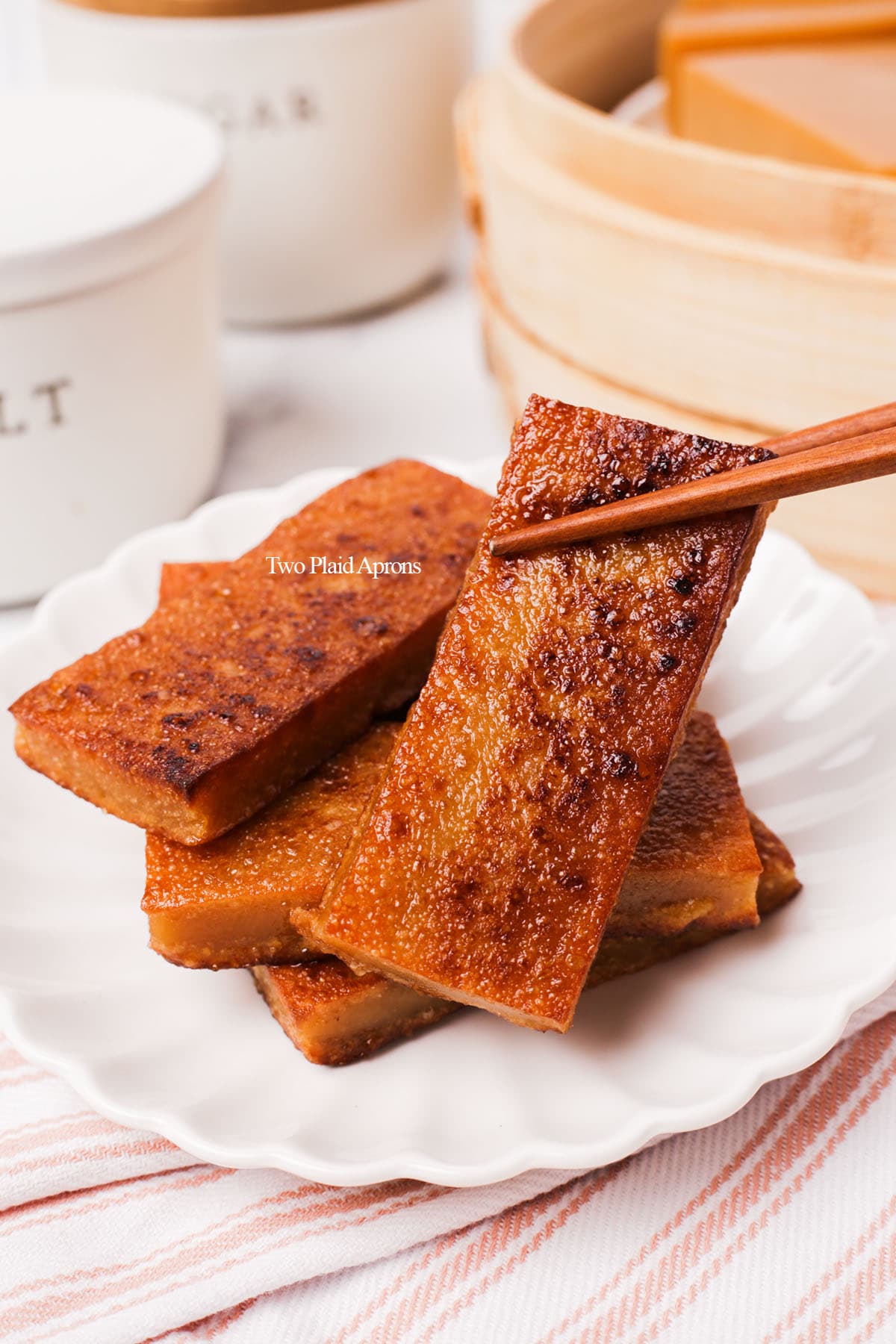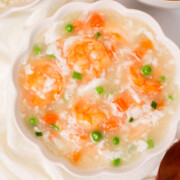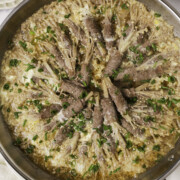Nian gao, or Chinese New Year rice cake, is one of the most popular food to make for Lunar New Year. It may look plain, but slice it up and pan fry it for a sweet, tasty treat that's crispy on the outside and soft and chewy on the inside. Totally additive! Plus, it needs only 5 ingredients to make. Looking for more LNY recipes? Complete your LNY menu with our pan fried pork and cabbage dumplings or pork and chive dumplings!

Nian gao (年糕), or sometimes referred to as brown sugar rice cake, is often gifted during Lunar New Year to wish families and friends a more prosperous year, since nian (年) translates to year and gao (糕) sounds like gao (高), which translates to higher, taller, better.
In its original, steamed form, nian gao can look very plain and not very intriguing. But once pan fried, it transforms into an additive snack that will tempt you for multiple seconds! Pan frying give nian gao the perfect crispness on the outside with a slight caramelized flavor and warms up the rice cake so the inside is soft and chewy.
Jump to:

Ingredient Notes
Please scroll down to the recipe card for the ingredient quantities!
- Coconut milk and water - The coconut milk gives richness to the nian gao batter and the water helps to thin out the batter to the right consistency. We recommend using full-fat coconut milk. DO NOT confuse it with coconut cream!
- Dark brown sugar - Nian gao are commonly made with Chinese brown sugar slabs or Chinese black sugar. Chinese brown sugar slab gives the rice cake a cleaner sweetness, while the the black sugar gives the rice cake a deeper, more molasses-y flavor and a darker color. However, they are usually harder to find, so dark brown sugar is a good substitute for them.
- Salt - Just a little pinch of salt helps to round out the flavor of the rice cake and makes it taste sweeter with less sugar.
- Rice flour - Nian gao is best made with a combination of both glutinous and regular rice flour. Glutinous rice flour gives the rice cake the iconic chew, like mochi, but don't worry! It's gluten-free. Regular rice flour gives the rice cake structure and helps to make the rice cake less sticky. Just make sure to grab the right bags! They tend to look very similar except for one word and the bag color. Always remember, glutinous rice four is the green bag ("g" for green), and the regular rice flour is the red bag ("r" for regular).
- Dry jujube (optional for garnish) - It's also known as dry red dates.

How to make nian gao (Chinese New Year rice cake)
Please scroll down to the recipe card for the full recipe and instructions!
1. Dissolve the sugar. Combine the coconut milk, sugar, and salt into a saucepan and heat until the sugar has dissolved, stirring frequently. No need to boil the mixture. The purpose is to dissolve the sugar. Stir in the cold water and set aside.




2. Prepare the equipments. Lightly grease an 8 inch can pan with nonstick spray and prepare a pot or pan of boiling water fitted with a bamboo steam basket or steaming rack.
3. Make the batter. Whisk together the two rice flour and slowly add the warm coconut milk mixture while mixing. Once the coconut mixture is all added, keep mixing until well combined and no more lumps or dry rice flour is visible.


🌟 Pro tip: Strain the batter through a sieve to remove any lumps from the nian gao batter.
4. Pour batter into the cake pan. Then, gently tap the pan on the counter to help pop any large bubbles. Place a dry jujube on top of the batter, in the center.


🌟 Pro tip: Cover the can pan with foil. This is optional and will help with keeping the top of the nian gao smooth. If doing so, remove the foil about 40 to 45 minutes into steaming.

5. Steam the nian gao. Place the pan of rice cake batter into the prepared steamer. Cover and steam the nian gao for about 55 to 60 minutes. The nian gao is cooked when a skewer or chopstick inserted into the center comes out with translucent rice cake and feels sticky.


6. Cool. Remove the can pan and let it cool until comfortable to handle. Then, flip the nian gao out of the pan and let it cool completely before covering and refrigerating.
How to eat nian gao
Although you can nian gao as it is, while it's warm. Nian gao is so much better pan fried! It becomes crispy on the outside and soft and chewy on the inside. Plus, the caramelization on the outside, really gives the sweet rice cake another depth of flavor!

To pan fry:
1. Cut chilled nian gao into pieces or slices no thinner than ¼ inch thick. The sweet rice cake can be thicker if you'd like, but no thinner.
2. Add a small amount of oil into a nonstick pan. Heat the pan over medium high heat. When the pan is hot, arrange the rice cakes in the pan and sear both sides until golden brown, about 1 to 2 minutes. If cut into sticks or chunks, sear all sides.
🌟 Pro tip: Pan sear the rice cakes until there are some dark brown spots for some extra caramelization and flavor. It's similar to roasting marshmallows.
3. Remove from the pan and cool for a moment. Enjoy while warm!

Recipe tips
- Add more water to the batter if needed. The nian gao batter should be similar consistency to condensed milk. So if needed, add a tablespoon of water at a time, until the batter is to the right consistency.
- Use full fat coconut milk. We highly recommend full fat milk to give nian gao a richer flavor. DO NOT use coconut milk drinks. They are usually sweetened and are too thin for this recipe.
- Chill the sweet rice cake for easier cutting. When the nian gao is warm, it will be very stick and hard to cut. We recommend letting it chill in the fridge for a few hours or even overnight. The rice cake will harden up after chilling, but it will cut smoothly and heat up really well.

Storage
Once the nian gao has completely cooled, cover well and refrigerate for up 5 days, or store in an airtight container and freeze for up to 4 months. Note that when the nian gao is chilled, it will become harder. That is normal and the rice cake will soften up again once heated.
If freezing, we recommend cutting the nian gao into your desired portion size first, or even cutting into slices before freezing. It is best to cut the nian gao once it is chilled, so that it's not as sticky. When ready to enjoy, simply let the rice cake thaw at room temperature or overnight in the fridge. Then, proceed with pan-frying it.

FAQ
If you want to, yes. You could use only glutinous rice flour. However, nian gao made with only glutinous rice flour tends to be stickier and the texture isn't as good.
If you prefer to make nian gao without coconut milk, you can use only water. If doing so, use ¼ cup less water and add a tablespoon of neutral oil.
If using light brown sugar, we recommend supplementing with some molasses. Light brown sugar is very light in molasses flavor and will make the batter very light in color. If using light brown sugar, we recommend adding 2 tablespoons of molasses per cup of sugar.
Yes! This nian gao recipe is completely gluten free and dairy free. Although it uses glutinous rice flour, don't let it deceive you. "Glutinous" simply refers to the mochi-like texture the rice flour will have when cooked.
If you’ve made this recipe or any recipes from our blog, please tag us on Instagram using #twoplaidaprons! You can also tag us in your Instagram stories using @two_plaid_aprons. We would love to see your creations! It absolutely makes our day! 🥰
📖 Recipe
Nian Gao (年糕 - Chinese New Year Rice Cake)
Ingredients
- 12 fl ounces coconut milk full fat (usually 1 can)
- 1¼ cup dark brown sugar packed (or Chinese black sugar)
- Pinch of salt (optional)
- ½ cup water cold
- 12 ounces glutinous rice flour
- 4 ounces rice flour
- Dry jujube (optional for garnish)
Instructions
Make the rice cake:
- In a saucepan, add the full fat coconut milk, brown sugar, and salt. Heat over medium heat and stir frequently until the sugar is completely dissolved. The coconut does not need to boil. Take the saucepan off the heat.
- Add the cold water into the sweetened coconut milk and stir to combine. Set aside to cool until warm to the touch.
- Prepare a pan or pot of boiling water fitted with a bamboo steam basket or steaming rack. Also prepare an 8 inch cake pan lightly greased with nonstick spray.
- In a large heatproof bowl, whisk together the glutinous rice flour and the regular rice flour. Pour the warm coconut milk mixture into the rice flour while whisking. Once all of the coconut milk has been added, keep whisking until the batter is smooth and no more lumps or dry rice flour are visible. The batter should be similar consistency to condensed milk.
- (Optional) Pour the batter through a sieve to strain out any lumps.
- Transfer the batter into the greased cake pan. Firmly tap the pan on the counter a couple of time to pop large bubbles. Place a dry jujube on the batter, in the center.
- (Optional) Cover the cake pan with a sheet of foil. This is totally optional and helps to ensure that the nian gao (rice cake) have a smooth surface on top. If covering with foil, remove the foil about 45 minutes into steaming.
- Place the cake pan into the prepared steam basket and steam the rice cake for about 55 minutes to 1 hour on medium heat.The rice cake is done when a skewer or chopstick inserted into the center comes out translucent and sticky like mochi.
- Carefully remove the nian gao from the steam basket and let it cool at room comfortable to handle. Then, flip the cake pan to remove the rice cake. Let the rice cake cool completely before covering. Refrigerate overnight or for up to 3 to 4 days.
Pan fried rice cake:
- Once the rice cake has been chilled, cut it in half, then into ¼ inch thick slices. Caution: Dry jujubes usually have a pit in the center. So be careful when cutting and eating!
- Add a small amount of oil to a nonstick pan over medium high heat. Once the pan is hot, arrange the rice cake slices in the pan. Pan fry each side for about 1 to 2 minutes, or until both sides are golden brown. Remove from the pan and repeat with as much rice cake as you'd like.
- Let the pan fried rice cakes for a couple of minutes and enjoy while they are warm!
Notes
- Sweetness - If you prefer your nian gao sweeter, use ¼ cup (50g) more brown sugar. For less sweet nian gao, use ¼ cup (50g) less.
- Steaming method - If you don't have a steam basket, you can also use a steaming rack or any steaming vessel you have. Just make sure the water is not touching the bottom of the cake pan. Also, make sure that there's sufficient space for the steam to travel. For example, don't use a steam basket that's too small for the cake pan.






















linda q begue says
i have tried other recipe with a little bit of wheat starch . came out really good and sliced easy and not sticky at all. nice texture.
Mei says
Hi Linda!
Thank you for trying out our recipe and leaving a feedback! So glad you enjoyed the rice cake and happy Year of The Tiger!
Mei ❤️